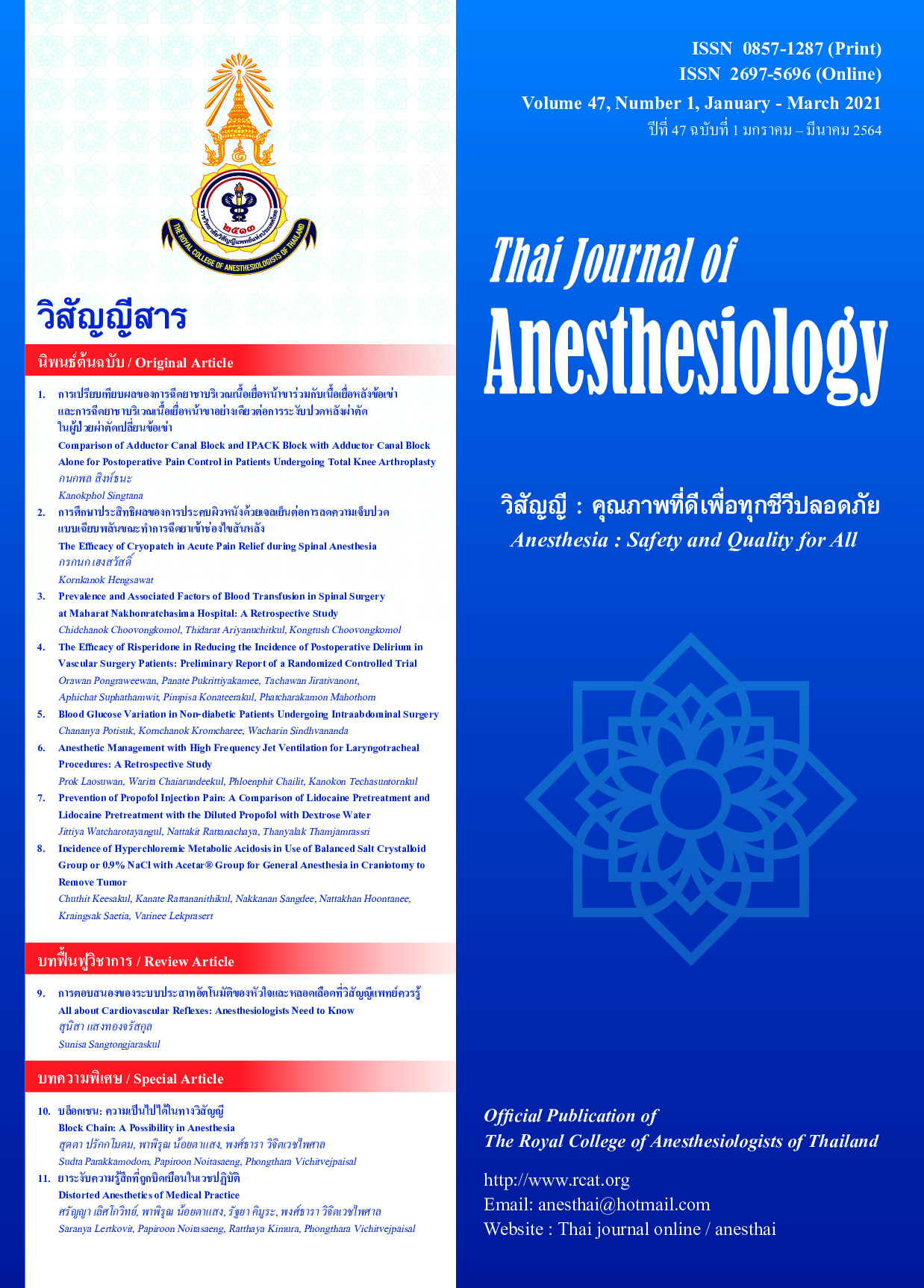Comparison of Adductor Canal Block and IPACK Block with Adductor Canal Block Alone for Postoperative Pain Control in Patients Undergoing Total Knee Arthroplasty
Main Article Content
Abstract
Background: Effective post-operative pain control in
patients undergoing total knee arthroplasty is a key
point which make patients early ambulation, effective
rehabilitation, early recovery, decrease length of hospital
stay and decrease peri-operative complications. In this
study, we hypothesized that adductor canal block with
IPACK block technique was more effective than adductor
canal block alone for post-operative pain control in TKA
cases.
Methods: Patients undergoing TKA in 2019-2020 total 16
cases were randomized into 2 groups. The first group was
ACB and IPACK block for post-operative pain control, and
second group was ACB alone. Numerical rating scale,
amount of analgesic drug, complications, and satisfaction
scores was recorded for compare between two groups.
Results: ACB with IPACK block showed statistically
significant less accumulative morphine used at 12 hours
postoperative period than ACB alone (1.5 1.6 ± vs 3.75 ±
1.39; p = 0.015). We found no significant differences in
the two groups with regard to numerical rating scale,
amount of analgesic drug, complications, and satisfaction
scores. Conclusion: ACB with IPACK block technique provide
effective post-operative pain control for TKA patients. This
technique significantly less accumulative morphine used
at 12 hours postoperative than ACB alone.
Article Details
References
femoral nerve blockade in conjunction with epidural
analgesia after total knee arthroplasty. Anesth Analg
2005;101:891-5.
2. Allen HW, Liu SS, Ware PD, et al. Peripheral nerve blocks
improve analgesia after total knee replacement surgery.
Anesth Analg 1998;87:93-7.
3. Baratta JL, Gandhi K, Viscusi ER. Perioperative pain
management for total knee arthroplasty. J Surg Orthop Adv
2014;23:22-36.
4. Grevstad U, Mathiesen O, Valentiner LS, et al. Effect of
adductor canal block versus femoral nerve block on
quadriceps strength, mobilization, and pain after total knee
arthroplasty: a randomized, blinded study. Reg Anesth Pain
Med 2015;40:3-10.
5. Jæger P, Zaric D, Fomsgaard JS, et al. Adductor canal block
versus femoral nerve block for analgesia after total knee
arthroplasty: a randomized, double-blind study. Reg Anesth
Pain Med 2013;38:526-32.
6. Mudumbai SC, Kim TE, Howard SK, et al. Continuous
adductor canal blocks are superior to continuous femoral
nerve blocks in promoting early ambulation after TKA. Clin
Orthop Relat Res 2014;472:1377-83.
7. Sankineani SR, Reddy ARC, Eachempati KK, et al.
Comparison of adductor canal block and IPACK block
(interspace between the popliteal artery and the capsule of
the posterior knee) with adductor canal block alone after
total knee arthroplasty: a prospective control trial on pain
and knee function in immediate postoperative period. Eur J
Orthop Surg Traumatol 2018;28:1391-5.
8. Thobhani S, Scalercio L, Elliott CE, et al. Novel regional
techniques for total knee arthroplasty promote reduced
hospital length of stay: An analysis of 106 patients. Ochsner
J 2017;17:233-8.


